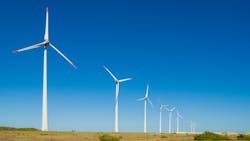DOE Announces $30 Million from Infrastructure Law to Speed Up Wind Energy Deployment
The Biden-Harris Administration, through the U.S. Department of Energy (DOE), yesterday announced its intent to use $30 million from President Biden’s Bipartisan Infrastructure Law to fund research and development projects that will lower costs for wind energy projects on land and offshore to benefit communities across the country. Wind energy accounted for more than 9% of total domestic electricity generation in 2021 and will play a significant role in achieving the goals to reach 100% clean electricity by 2035 and a net-zero-emissions economy by 2050.
“Wind power is abundant, homegrown, affordable, and already provides enough electricity to power 40 million homes,” said U.S. Secretary of Energy Jennifer M. Granholm. “But that is just the start — wind power is poised for explosive growth. Thanks to President Biden’s Bipartisan Infrastructure Law, DOE is helping to break down technology barriers to turbo-charge the deployment of this affordable resource all across the country.”
These investments, together with the Inflation Reduction Act — which provides market certainty and incentives for domestic wind energy component manufacturing — is intended to bolster the continued growth of wind energy and reinforce its key role as an American-made clean energy resource. The investments also further the Biden-Harris Administration’s efforts to jumpstart the American offshore wind industry and reach 30 gigawatts (GW) of offshore wind by 2030, enough to power 10 million homes with clean energy, support tens of thousands of jobs, and spur private investment up and down the supply chain.
Notice of Intent (NOI) to Issue Bipartisan Infrastructure Law Funding for the Reduction of Barriers to Offshore, Land-Based, and Distributed Wind Deployment
Applicants for the forthcoming $28 million funding opportunity must submit projects that support the following initiatives:
- Advancing technologies needed to transmit large amounts of electricity from offshore wind over long distances. Funding in this topic area ($9.7 million) will support standards for high-voltage direct current (HVDC) transmission for offshore wind, develop and validate innovative controls to ensure reliability and compatibility with alternating current and direct current, and identify and address gaps in education and workforce training to support HVDC transmission deployment for U.S. offshore wind.
- Helping coastal communities benefit from offshore wind development through social science research and community engagement. Funding in this topic area ($6.9 million) will help characterize economic and other impacts of offshore wind development on local communities, and support research enabling communities to better participate in, and benefit from, offshore wind development.
- Improving permitting processes to make distributed wind more accessible to communities where distributed wind can be cost-effectively and equitably deployed. Distributed wind energy, which is wind that provides power for nearby homes, farms, schools, and businesses, can help communities transition to low-carbon energy. However, established zoning and permitting processes for distributed wind are not present in all municipalities, and others have burdensome requirements that discourage development. To reduce costs and accelerate the equitable deployment of community-based clean energy, funding in this topic area ($3.3 million) will support innovative zoning and permitting approaches for distributed wind projects that leverage successes that have been achieved in permit reform for distributed solar photovoltaics and that work for communities and industry alike.
- Improving technologies that help bats avoid wind turbines as the industry works to minimize impacts to local wildlife and ecosystems. Funding in this topic area ($8 million) will support bat behavioral research, technology development, and field testing to advance bat deterrent technologies.
Read the full Notice of Intent for the forthcoming funding opportunity on EERE Exchange.
Anchoring and Mooring Request for Information (RFI)
In support of the Floating Offshore Wind Energy Earthshot and to inform $2.5 million in future R&D funded by the Bipartisan Infrastructure Law, DOE released an RFI on research needs for the anchors and mooring systems that attach floating offshore wind structures to the sea floor in deep water.
The Biden-Harris Administration has set a goal of deploying 15 GW of floating offshore wind by 2035, enough to power 5 million homes with clean energy, while supporting state offshore wind deployment and bringing these economic opportunities to more regions. Information obtained from the RFI will inform future work funded by the Bipartisan Infrastructure Law to advance floating offshore wind toward cost-effective commercialization and domestic manufacturing, including the technologies that keep floating turbines in place at sea.
Read the RFI on EERE Exchange. Responses must be submitted by December 19, 2022.
These investments will complement ongoing work at DOE to enable the innovations needed to advance U.S. wind systems, reduce the cost of electricity, and accelerate the deployment of wind power. Learn more about the Wind Energy Technologies Office in DOE’s Office of Energy Efficiency and Renewable Energy.
